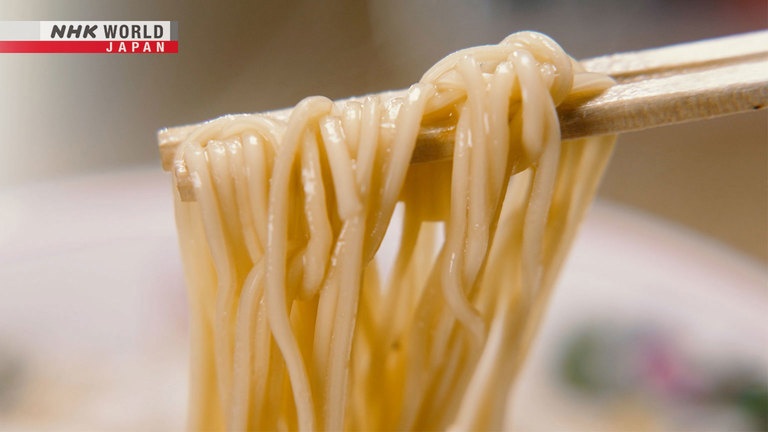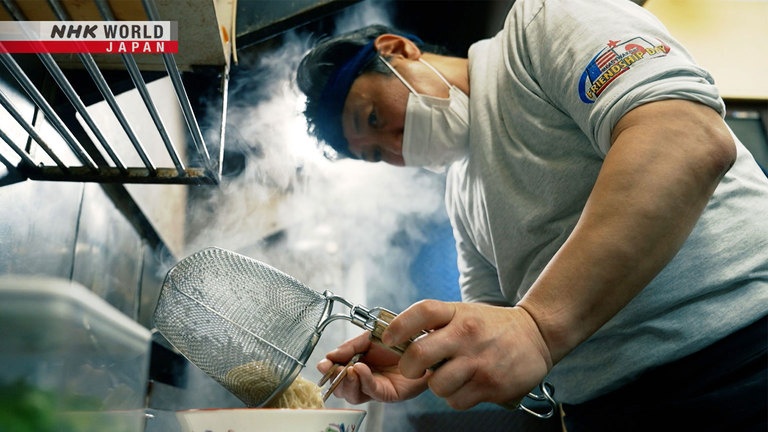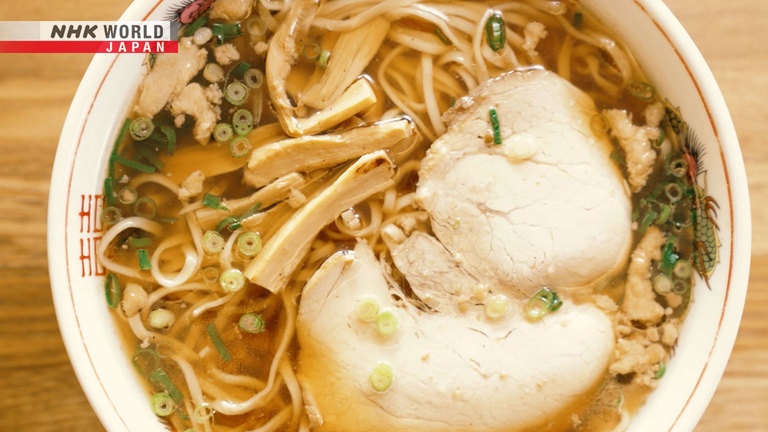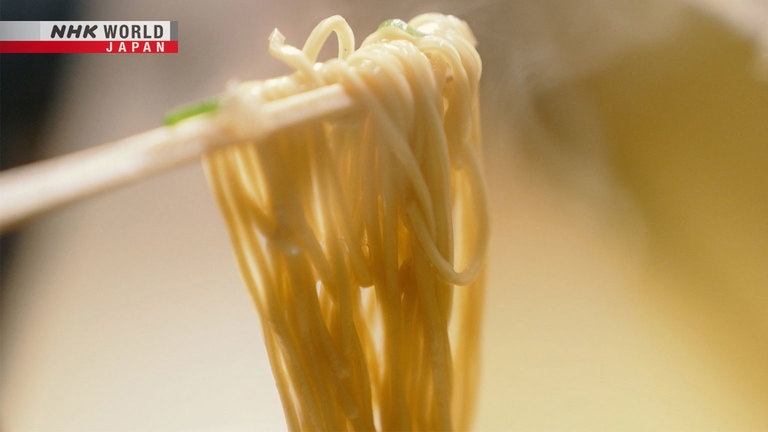HIROSHIMA
Two local takes on ramen that kept Hiroshima fed during postwar reconstruction; flavors passed down for generations.




Transcript
RAMEN JAPAN!
This time, in Hiroshima.
Born from humble food stalls, this is the story of Hiroshima's two beloved styles of ramen.
This is Hiroshima ramen. My favorite!
Welcome to Japan, the land of ramen!
Hiroshima Prefecture in western Japan.
Our first stop is Hiroshima City, its capital.
August 6th, 1945.
The first ever use of the atomic bomb on a populated area, the city of Hiroshima is almost completely destroyed.
After the war, the black market supported the lives of the people as they rebuilt their city.
Food stalls were a common sight.
These stalls gave rise to one of Hiroshima's favorite dishes.
Okonomiyaki, a mixture of wheat flour batter, vegetables and meat.
The Hiroshima variety also includes noodles, and is still a local favorite.
This longstanding Hiroshima noodle maker was founded in 1950.
The second-generation owner Harada Koji was born in the year of the atomic bombing.
I was exposed to radiation in utero.
In the bombing, the roof collapsed
on my mother, she was screaming.
My father got her out, and they fled.
I didn't see it, but my mother
was in tears when she told me.
It was a time of food shortages.
Flour provided by the occupying US military was used to make noodles that people grew to love.
It forever changed the city's landscape.
There were food stalls on nearly
every street corner of the city.
Amidst the crowd of okonomiyaki stalls, of course deliveries of noodles also went to...
Ramen sellers!
This shop got its start as a food stall in 1948.
Preparation, ingredients, and of course taste all remain unchanged.
Hiroshima ramen uses a soy-sauce
and pork-bone stock soup base.
As a rule, that flavor is preserved.
I come here all the time;
for nearly 30 years now.
I give it a 97 out of 100,
a pretty high score.
Why? Because it doesn't linger.
The flavor isn't overpowering.
It's the same for relationships.
The counter still has a food stall vibe.
All the old Hiroshima ramen places
always have "oden" stew too.
That and a cup of sake, then ramen,
and going home is food stall holdover.
Lots of customers don't want us to stop.
Whenever folks come back, even after
30 or 40 years, they'll always have it.
And seeing the joy on their faces
is enough reason for us to keep it up.
Ramen's popularity spread rapidly in postwar Hiroshima.
And a single individual was responsible for determining its distinctive taste.
Editor-in-chief of a local town magazine, Anan Masashi
has been reporting on what's new in Hiroshima for over half a century.
It's said Oki Minoru was the first
to introduce ramen in Hiroshima.
After returning from China,
he started a food stall,
and this is believed to be
the origin of Hiroshima ramen.
The taste developed by Oki gradually spread all over the city through shops opened by those who learned from him.
And this is one of them.
Soy sauce blended with pork bone broth is the starting point for its rich flavor.
And since the shops founding, as it passed from generation to generation, that flavor has been preserved.
Since it's a family-run business
you can really taste that flavor
passed down for generations.
It's not just taste, it has real heart.
In all seriousness, I want to have
their ramen for my final meal.
These days, the shop is run by Hara Hiromi, but the business was started by her husband's parents.
It was a food cart, so my father-in-law
walked around town blowing a whistle,
saying "how about some ramen,"
it was nighttime work.
My mother-in-law worked during the day,
and the noodle shop ran till midnight.
It was hard for them back then.
Since the days of the food cart, ramen has been the only item on the menu.
I always say my mother-in-law
only ever taught me one thing.
It's just a simple bowl of ramen,
but if you put your heart into it
then people will love every bite.
The shop passed from father to son.
She thought they would continue to preserve that all-important flavor
as husband and wife until her husband was diagnosed with cancer.
But Hiromi had no time for grief.
He died six months after the diagnosis.
Every day at the hospital for about
two months, I'd ask about the soup,
and our daughter would ask him
about keeping the accounts.
The aim was to preserve the family legacy.
That sense of purpose was all that kept her going.
I kept the soup cooking on the day
of his funereal and the day after,
so that it would never run out.
Carrying on was my only option.
An unchanging taste loved by all Hiroshima.
An unforgettable hometown dish linking past and present, carrying on to the next generation.
About 90 kilometers from Hiroshima, the town of Onomichi has long had a thriving shipbuilding industry.
It was bombed during the war, suffering a degree of damage, but it retains its old-time feel.
It's also home to Onomichi ramen.
This is the first ever shop to use the term "Onomichi ramen."
Using both chicken and pork bone stock, over straight noodles,
the key to its distinctive taste is the addition of pork back fat.
Since its founding in 1973, this has been their "Onomichi ramen."
Pork back fat in a soy sauce base,
but not just any back fat.
Quality fat has a more mellow flavor.
Today, as usual, tourists come from all over.
In western Japan, Onomichi ramen
has real name recognition.
It's not to fatty, and the soup
stays warm till the last bite.
It's because of the coating of fat.
Delicious!
A generous helping of pork back fat, Onomichi style!
The origins of its distinctive taste began here at this shop.
Chicken stock is poured over the noodles, and then backfat simmered in soy sauce for an infusion of flavor is blended in.
It was the first ramen to feature back fat.
The one who created it was the shop's first owner, Danjo Masayoshi.
Now, his daughter, Syunko carries on in his footsteps.
Mom and dad started with a food stall.
You could call it nostalgia, but to me,
it's a taste worth preserving.
When they began it was a time of scarcity, which is why they looked to pork back fat.
Right after the war, food was scarce.
Dad wanted to make the best ramen
he could, so he tried back fat.
Mom said it sold well right away.
Today, for the residents of Onomichi, it's simply irreplaceable.
It's been 50 years. I come once a week.
I have children, grandchildren,
and even great grandchildren.
I always bring them here when they come.
This is the real taste of Onomichi ramen.
Another shop that started out as a food stall after the war still remains in Onomichi.
Second-generation owner, Nii Hiroaki.
Here too, back fat is key.
Since it started in 1948, the soup has been passed down from generation to generation.
I stay true to the taste dad made.
This is actually the hardest part.
When a regular finally told me
that I had got the flavor just right,
it honestly made me so happy.
The crisp back fat and soy sauce
made the flavor so delicious.
It's been ten years, and I'm so glad
that I came here to eat today.
His father started a ramen stall with no prior experience.
This too was linked to the atomic bombing that took place in Hiroshima.
Dad worked for the national railway,
living near the freight depot in Hiroshima.
But just before the atomic bomb hit,
he was in Onomichi on business.
If he hadn't been here for work,
I would never have been born.
He was lucky to survive, though it feels
unfair to the people who were bombed.
A story of miraculous survival.
His father's image, reflected in every bowl.
They had children to feed.
Dad had lost his job, so my
parents did what they had to,
and ended up making ramen.
I'm just doing my best make it
the way they did in the old days.
As they rose from the war's ashes, a taste that came to be loved by the people of Hiroshima, passed down unchanged.
Wouldn't you like to try some yourself?
Come pay a visit for the best bowl of ramen you've ever had!